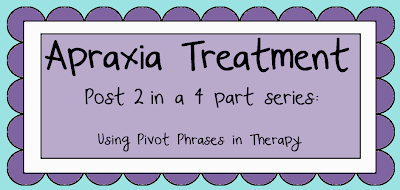Pivot phrases (or carrier phrases, depending on your preferred terminology) can be *so* beneficial in working with kids not only with apraxia, but with a lot of young language-delayed kids in general. Pivot/carrier phrases are phrases where the one part of the phrase (i.e. the first two words) stay the same throughout the activity, but the last word changes. Some examples are…
*I want ….
*I like ….
*I see ….
*Put on ….
*Take out ….
*Open …
Carrier phrases are typically 2-3 words, and are great to implement when a child has obtained some consistent single word approximations, but isn’t yet combining multiple words together. Using pivot/carrier phrases gives the child the opportunity for lots of repetitive practice in sequencing sounds and words together, which is key for motor learning! Carrier phrases allow you to work on the expressive language piece of communication (by combining multiple words together) while still working on successive approximations on the accuracy/clarity of the words produced.
Let’s take the carrier phrase, “open ___,” as an example. If a child is only producing single consonant or vowel sounds for words (i.e. produces “o” for “open”), you could facilitate a step up by working on VCV and CV approximations such as “o-pih” or “o-puh” while using it in a carrier phrase (i.e. “o-pih bah” for “open box” or “o-pih du” for “open juice.”). This way, you’re still facilitating a higher level of motor speech production than what they are doing spontaneously (but not too high a level where they can’t be successful), while still encouraging and facilitating the use of multiple word combinations.
Carrier phrases are also great because they’re predictable. They reduce the “linguistic load,” so the child doesn’t have to think as much about what they are going to say. Sequencing is such a challenge for kids with apraxia, especially those just starting their journey in speech therapy, so anything that can help it become more automatic, from my experience, seems to help a ton!
In addition to kids with apraxia, I’ve found that carrier phrases work really well with preschoolers who have language delays and aren’t combining many words together. Carrier phrases are predictable, making it easier for the kids to “catch on” to what I’m expecting them to do, and they start using the 2-3 word combinations more consistently with less cuing/modeling from me!
Some of the ways I incorporate these into activities in speech:
*Playing “Memory” with speech cards (“I got ___” or “I see __”)- I typically have two sets of words they’re working on (i.e. VCV or CVCV words, etc…) and use those as the target words.
*Go Fish with speech cards (“You have ___?”)
*Looking at books: Books with repetitive, predictable text like Eric Carle’s “Brown Bear, Brown Bear” are great for using carrier phrases (“I see a…”), but really, any book can work! You can flip through the pages and use the carrier phrase “I see ___”) to point out different pictures you see on each page.
*Mr Potato Head: I might have them use “I want” to tell me the different parts they want, i.e. “I want hat” or “I want eyes.” I might also use “put on” to have them tell me they want to “put on hat” or “put on feet.” Another one you could use is “___ go on” like “hat go on” or “nose go on.”
*Beanbags! I’m not sure if I’ve professed my love of beanbags enough, but they are seriously amazing. Bubbles and beanbags are two of my kids’ favorite things! With beanbags, we might throw them onto pictures of their speech words and use the phrase “Bag on ___” to name and practice the word their beanbags land on.
*Candyland– A lot of my little ones are working on learning their colors in the classroom. With Candyland, I can reinforce those concepts, use some color words as targeted words for motor speech practice, and use pivot phrases like “I got (color)” for every card they draw.
*Putting toys in or on something…anything, really! For instance, using a farm set and saying “(farm animal) go in” when they’re going in the barn… or cooking pretend food with a kitchen set (“(food) in pan” or “(food) on plate”)… so many possibilities in play! “In” “On” and “Out” are easy words to incorporate into carrier phrases, and are great for targeting final consonants, too! 🙂
*Any sort of “I Spy,” Flashlight game, or sensory tub activity where pictures or objects are hidden in a tub of sand/corn/etc… “I found” or “I see” are great carrier phrases to use with these types of activities!
What are some of your go-to activities in using pivot phrases during your therapy sessions? I’d love to hear your ideas!!


Great article on pivot phrases for CAS. When will #3 in the series be published?